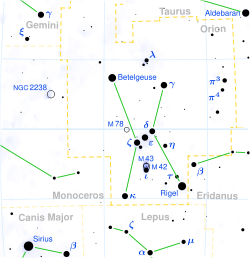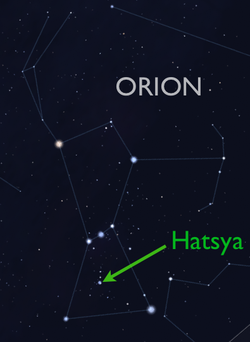- Iota Orionis
-
Iota Orionis A/B Observation data
Epoch J2000 Equinox J2000Constellation Orion Right ascension 05h 35m 26s Declination -05° 54′ 36″ Apparent magnitude (V) 2.77 Characteristics Spectral type O9 III/B1 III U−B color index -1.08 B−V color index -0.24 Variable type ? Astrometry Radial velocity (Rv) 22 km/s Proper motion (μ) RA: 2.27 mas/yr
Dec.: -0.62 mas/yrParallax (π) 2.46 ± 0.77 mas Distance approx. 1300 ly
(approx. 400 pc)Absolute magnitude (MV) -5.3 Details Mass 15 M☉ Luminosity 12,600 L☉ Temperature 31,500 K Rotation 130 km/s. Other designations Iota Orionis (ι Ori, ι Orionis) is the brightest star in Orion's sword, and is located at the tip of the sword. It has the traditional names Hatsya (sometimes with the typographic error Hatysa), or in Arabic, Na’ir al Saif, which means simply "the Bright One of the Sword."+-9*
Iota Orionis is a quadruple system dominated by a massive spectroscopic binary with an eccentric (e=0.764), 29-day orbit. The binary is composed of a class O9 III star (blue giant) and a class B1 III star.[1] The collision of the stellar winds from this pair makes the system a strong X-ray source.
Reference
- ^ Stickland, D. J.; Pike, C. D.; Lloyd, C.; Howarth, I. D. (October 1987). "A study of the massive O-type binary IOTA Orionis". Astronomy and Astrophysics 184 (1-2). Bibcode 1987A&A...184..185S. ISSN 0004-6361.
External links
- Iota Orionis by Dr. Jim Kaler.
- David Darling's encyclopedia entry
Stars of Orion Bayer α (Betelgeuse) • β (Rigel) • γ (Bellatrix) • δ (Mintaka) • ε (Alnilam) • ζ (Alnitak) • η (Algjebba) • θ¹ (Trapezium Cluster: θ¹ A • θ¹ B • θ¹ C • θ¹ D) • θ² • ι (Hatsya) • κ (Saiph) • λ (Meissa) • μ • ν • ξ • ο¹ • ο² • π¹ • π² • π³ (Tabit) • π4 • ρ • σ • τ • υ (Thabit) • φ¹ • φ² • χ¹ • χ² • ψ • ω • b • c • d • e • f¹ • f² • g • h • i • k • l • m • n¹ • n² • o • p • AFlamsteed 1 (π³, Tabit) • 2 (π²) • 3 (π4) • 4 (ο¹) • 5 • 6 (g) • 7 (π¹) • 9 (ο²) • 11 • 12 • 13 • 14 (i) • 15 • 16 (h) • 17 (ρ) • 18 • 19 (β, Rigel) • 20 (τ) • 21 • 22 (o) • 23 (m) • γ (Bellatrix) • 25 • 26 • 27 (p) • 28 (η, Algjebba) • 29 (e) • 30 (ψ) • 31 • 32 (A) • 33 (n¹) • 34 (δ, Mintaka) • 35 • 36 (υ, Thabit) • 37 (φ¹) • 38 (n²) • 39 (λ, Meissa) • 40 (φ²) • 41 (θ¹, Trapezium Cluster: θ¹ A • θ¹ B • θ¹ C • θ¹ D) • 42 (c) • 43 (θ²) • 44 (ι, Hatsya) • 45 • 46 (ε, Alnilam) • 47 (ω) • 48 (σ) • 49 (d) • 50 (ζ, Alnitak) • 51 (b) • 52 • 53 (κ, Saiph) • 54 (χ¹) • 55 • 56 • 57 • 58 (α, Betelgeuse) • 59 • 60 • 61 (μ) • 62 (χ²) • 63 • 64 • 65 • 66 • 67 (ν) • 68 • 69 (f¹) • 70 (ξ) • 71 • 72 (f²) • 73 • 74 (k) • 75 (l)Nearby Other Categories:- Bayer objects
- O-type giants
- B-type giants
- Orion constellation
- Spectroscopic binaries
- Multiple star systems
- Stars with proper names
- Giant star stubs
Wikimedia Foundation. 2010.


